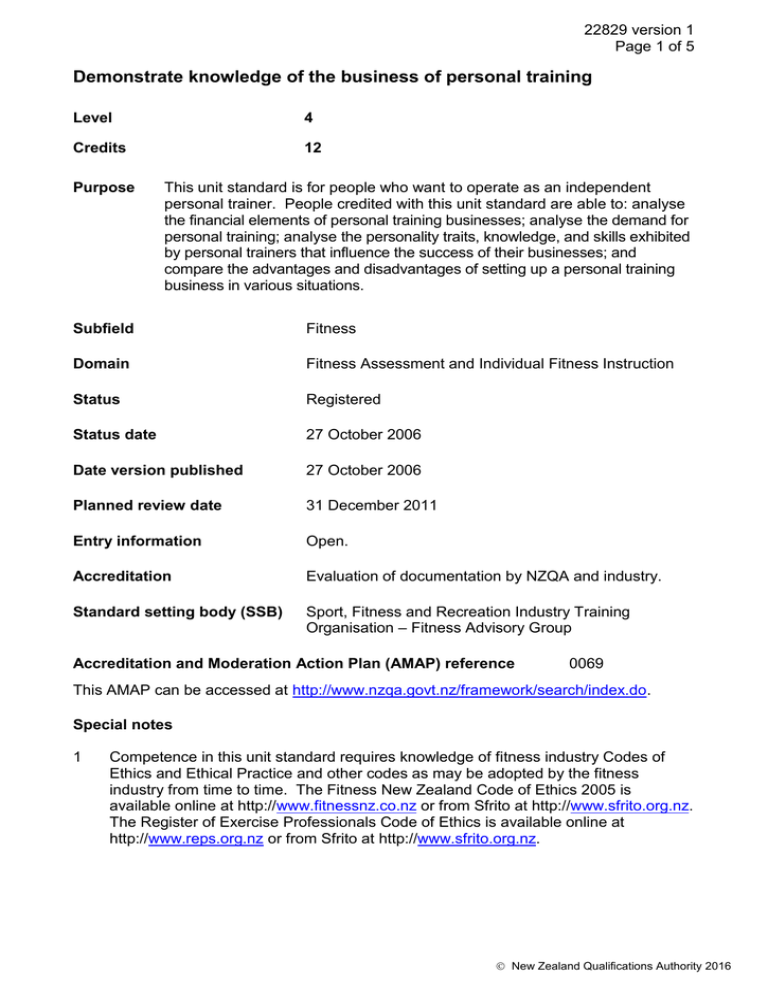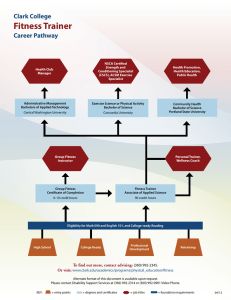Demonstrate knowledge of the business of personal training
advertisement

22829 version 1 Page 1 of 5 Demonstrate knowledge of the business of personal training Level 4 Credits 12 Purpose This unit standard is for people who want to operate as an independent personal trainer. People credited with this unit standard are able to: analyse the financial elements of personal training businesses; analyse the demand for personal training; analyse the personality traits, knowledge, and skills exhibited by personal trainers that influence the success of their businesses; and compare the advantages and disadvantages of setting up a personal training business in various situations. Subfield Fitness Domain Fitness Assessment and Individual Fitness Instruction Status Registered Status date 27 October 2006 Date version published 27 October 2006 Planned review date 31 December 2011 Entry information Open. Accreditation Evaluation of documentation by NZQA and industry. Standard setting body (SSB) Sport, Fitness and Recreation Industry Training Organisation – Fitness Advisory Group Accreditation and Moderation Action Plan (AMAP) reference 0069 This AMAP can be accessed at http://www.nzqa.govt.nz/framework/search/index.do. Special notes 1 Competence in this unit standard requires knowledge of fitness industry Codes of Ethics and Ethical Practice and other codes as may be adopted by the fitness industry from time to time. The Fitness New Zealand Code of Ethics 2005 is available online at http://www.fitnessnz.co.nz or from Sfrito at http://www.sfrito.org.nz. The Register of Exercise Professionals Code of Ethics is available online at http://www.reps.org.nz or from Sfrito at http://www.sfrito.org.nz. New Zealand Qualifications Authority 2016 22829 version 1 Page 2 of 5 2 Competence in this unit standard requires knowledge of relevant provisions of statutes including the Health and Safety in Employment Act 1992, Injury Prevention, Rehabilitation, and Compensation Act 2001, Fair Trading Act 1986, Consumer Guarantees Act 1993, Privacy Act 1993, and subsequent amendments. 3 Definitions A lead – is any person for whom the candidate knows their overall goal, current state, time-frames, and reasons for initially taking action. Conversion rate – is the number of leads who accept the offer to become customers/clients divided by the number of leads the personal trainer asks to train with them multiplied by 100. For example, twenty customers divided by forty leads multiplied by one hundred equals a fifty percent conversion rate. Customer or client – refers to any person who is training with a personal trainer and paying in some way for that service. Average spend – is the amount of income divided by the number of customers in a given period. For example, an income of three thousand dollars per month divided by twenty customers results in an average spend of one hundred and fifty dollars per customer. Frequency of spend – is the number of times in a given period the customer completes a transaction with the personal trainer. For example, fifty transactions in a month divided by twenty customers equates to two and a half transactions per customer. Fitness facilities – refers to any organisation where exercise takes place for the purposes of fitness improvement or maintenance and includes but is not limited to: fitness clubs, personal training studios, recreation centres, and physical rehabilitation clinics. Fitness industry – refers to the New Zealand fitness industry and is intended to include fitness activities and enterprises conducted under the aegis of the community and voluntary sectors. Elements and performance criteria Element 1 Analyse the financial elements of personal training businesses. Performance criteria 1.1 The income and expense generating elements of personal training businesses are analysed in terms of their effect on gross profit and cash flow. Range 1.2 leads, conversion rate, customers, average spend, frequency of spend, gross turnover/total income, fixed costs, variable costs, gross costs/total expenses, margins, gross profits; evidence is required for at least three personal training businesses. The taxes due when running a personal training business are analysed in terms of their effect on net profit and cash flow. Range goods and services tax, income tax, fringe benefit tax, accident compensation corporation levies, tax payment cycles (provisional and terminal), options for reserving funds for taxation purposes. New Zealand Qualifications Authority 2016 22829 version 1 Page 3 of 5 1.3 How the income, expense and tax elements of a personal training business can be managed through financial planning is analysed in terms of optimising the financial performance of the business. Range 1.4 cash flow forecast, statement of financial performance, statement of financial position, financing options, asset acquisition, depreciation, management of contingent liabilities; evidence is required for at least three personal training businesses. How business financial records should be kept to allow for the effective financial management of a personal training business is explained. Range receipts, payments, invoicing, cashbook. Element 2 Analyse the demand for personal training. Range at least six customer cases, four who have previously or are currently using a personal trainer and two who have never used a personal trainer. Performance criteria 2.1 Analysis of customer cases is used to explain the needs customers may have when implementing a personal exercise programme with a personal trainer. Range 2.2 must include but is not limited to – goals, timeframes, barriers, preferences. Analysis of customer cases is used to explain the features and benefits experienced by customers when using a personal trainer. Range features may include but are not limited to – exercise testing, instruction, programming and planning, nutritional guidance, personal support, safe exercise, effective exercise, exercise adherence, results, clarity of purpose and progress, personal attention and empathy, entertainment; benefits may include but are not limited to – physical changes (for example clothes fitting, being able to play a sport again, less pain, less fatigue), psychological changes (for example feelings of happiness, control, satisfaction, awareness, reduction in frustration and boredom, reduction in perceived risk of failure, increase in perceived likelihood of success). New Zealand Qualifications Authority 2016 22829 version 1 Page 4 of 5 Element 3 Analyse the personality traits, knowledge, and skills exhibited by personal trainers that influence the success of their businesses. Range at least three different personal trainers. Performance criteria 3.1 The personality traits exhibited by the personal trainers are analysed in terms of their suitability for working with customers and operating in the fitness industry. Range 3.2 The areas of knowledge used by personal trainers are analysed in terms of their value in meeting customer expectations and operating a successful personal training business. Range 3.3 areas of knowledge considered must include but are not limited to – exercise physiology, anatomy, fitness testing and exercise prescription, human behaviour, nutrition, promotion and sales, financial, insurance and legal. The skills used by personal trainers are analysed in terms of their use in delivering customer value and operating a successful personal training business. Range 3.4 may include but is not limited to – levels of confidence; selfdetermination; self-efficacy; resilience; motivation; attitude to exercise, business, clients, competition, particular types of work (for example administration, sales, contract negotiations). skills must include but are not limited to – oral communication, listening, needs analysis, generating and proposing solutions, negotiation, time management, business planning, business administration and risk analysis, teaching and coaching, exercise prescription. The influence of the personal trainer’s personality traits, knowledge, and skills on the success of their business is explained. New Zealand Qualifications Authority 2016 22829 version 1 Page 5 of 5 Element 4 Compare the advantages and disadvantages of setting up a personal training business in various situations. Range at least three situations must be compared, one within an existing fitness facility, one as a new independent personal training studio, and one as a mobile homebased personal training service. Performance criteria 4.1 The advantages and disadvantages of setting up a personal training business in various situations are compared in terms of the requirements for financing, marketing, operating, and exiting the business. Range must include but is not limited to – financial requirements such as capital outlay, record keeping, debt management, financial advice, insurance; marketing requirements such as lead generation (through advertising and promotional activities); operational requirements such as policies and procedures, payment options, sales systems, equipment and facility supply and maintenance, compliance with legislation and codes of ethics, insurance; exiting the business in terms of trading history, good will, assets and liabilities. Please note Providers must be accredited by the Qualifications Authority, or an inter-institutional body with delegated authority for quality assurance, before they can report credits from assessment against unit standards or deliver courses of study leading to that assessment. Industry Training Organisations must be accredited by the Qualifications Authority before they can register credits from assessment against unit standards. Accredited providers and Industry Training Organisations assessing against unit standards must engage with the moderation system that applies to those standards. Accreditation requirements and an outline of the moderation system that applies to this standard are outlined in the Accreditation and Moderation Action Plan (AMAP). The AMAP also includes useful information about special requirements for organisations wishing to develop education and training programmes, such as minimum qualifications for tutors and assessors, and special resource requirements. Comments on this unit standard Please contact the Sport, Fitness and Recreation Industry Training Organisation Limited info@sfrito.org.nz if you wish to suggest changes to the content of this unit standard. New Zealand Qualifications Authority 2016


